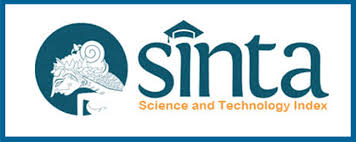
indexed in SINTA (No. SK : 30/E/KPT/2019)
Author Guidelines
Before prepare and submit article manuscripts, please note that author(s) are discouraged from withdrawing submitted papers after it is in the publication process (review, copyedit, layout, etc.,). During the time, JILP had spent valuable resources besides time spent in the process.
Please prepare your manuscript before submission, using the following guidelines:
Format
Article files should be provided in Microsoft Word format. We currently do not accept other formats, such as LaTex or PDF files.
Article Length
Articles should be between 10-15 pages, including references. A maximum of 4 pages long appendices are allowed.
Article Title
A title of 10 (ten) words maximum should be provided.
Author Details and Authorship
All contributing authors’ names should be added, and their names arranged in the correct order for publication. A correct email address should be supplied only by the corresponding author. The full name of each author must be present in the exact format they should appear for publication, including or exclude any middle names or initials as required. The affiliation of each contributing author should be correct on their individual author name. The criteria of authorship are as follows; Substantial contributions to the conception or design of the work; or the acquisition, analysis, or interpretation of data for the work; Drafting the work or revising it critically for important intellectual content; Final approval of the version to be published; Agreement to be accountable for all aspects of the work in ensuring that questions related to the accuracy or integrity of any part of the work are appropriately investigated and resolved.
Structured Abstract
Authors must supply a structured abstract in their submission, which includes:
-Purpose
-Design/methods/approach
-Findings/results
-Conclusions
A maximum of 350 words in total excluding keywords. It has to be in English regardless of the articles content's languages.
Keywords
Authors should provide appropriate and short keywords that encapsulate the principal topics of the paper. The maximum number of keywords is 5 (five) phrases.
Article Organization
The body of articles should be organized (at least) into the IMRaD structure as follow;
-Introduction Section provides adequate background or context (problem and its significance) of the study. The subject should not be written extensively. It is expected that the rationale or purpose of the study (gap analysis), the objective in general and specific, and hypothesis (if any) should be expressed clearly. Present a clear "state of the art" of the subject, which discussed literature and theoretical concepts behind it. A concise general background may be included in the article. Present at least 5 (five) recent related works to support the novelty of the research.
-Methods Section provides sufficient details to allow the work to be reproduced by an independent researcher. Methods that are already published should be summarized and indicated by a reference. If quoting directly from a previously published method, use quotation marks and also cite the source. Any modifications to existing methods should also be described. Indicate the participants observed, including demographic data, number of respondents, the rationale of respondents selection, etc. Describe the design of the experiment, such as the experiment procedures, surveys, interviews, observation characteristics, etc. Write the complete research procedure. Be sure that explanations made in the article will allow other researchers to reproduce the work, or make future work out of it.
-Results and discussions. Write results in a logical sequence. Results with important findings should be present first. When presenting results in a table or figure, do not repeat all those contents in the text. Present only the summary of the text. Describe only new and important aspects of the study. Do not repeat all information from the results section or any section above. Present limitations of the study. Write the issues that are new or unsolved, for future research. This section consists of the information on What/How the presented data were produced, no raw data should be present in the article. The produced data are presented in tables, or figures with an explanation of what is the result/findings from the work. The section will also need to address connections between findings and basic concepts or hypothesis made earlier. Authors should also express whether any arguments were needed relating to other works from other researchers. Write implications made by the work related to theoretical or applications.
-Conclusions Section. The conclusion should be linked to the title and objectives of the study. Do not make statements not adequately supported by your findings. Write the improvements made to the industrial engineering field or science in general. Do not make further discussions, repeat the abstract, nor only list the results of research results. Do not use bulleted points, use paragraphed sentences instead.
Biographies and Acknowledgments
Those who contribute but do not meet all criteria for authorship should not be listed as authors, but they should be acknowledged at the end of the text. Only the names of the persons but not their role should be written under the acknowledgment section. Authors must declare all sources of external research funding in their article and a statement to this effect should appear in the Acknowledgements section. Authors who wish to include these items should save them together in the MS Word file to be uploaded with the submission. If they are to be included, a brief professional biography of 100 words maximum should be supplied for each named author.
Article Categories
Authors must categorize their paper as part of the article information. The category which most closely describes their paper should be selected from the list below.
-Research paper. This category covers papers which report on any type of research undertaken by the authors. The research may involve the construction or testing of a model or framework, action research, testing of data, market research or surveys, empirical, scientific or laboratory research.
-Technical paper. Describes and evaluates technical products, processes or services.
-Conceptual paper. These papers will not be based on research but will develop hypotheses. The papers are likely to be discursive and will cover philosophical discussions and comparative studies of others' work and thinking.
-Case study reports. Case studies describe actual interventions or experiences within organizations. They may well be subjective and will not generally report on research. A description of a legal case or a hypothetical case study used as a teaching exercise would also fit into this category.
Headings
Headings must be concise, with a clear indication of the distinction between the hierarchy of headings. The format is provided in the article's template.
Notes/Endnotes
Notes or Endnotes should be used only if absolutely necessary and must be identified in the text by consecutive numbers, enclosed in square brackets and listed at the end of the article.
Figures
All Figures (charts, diagrams, line drawings, web pages/screenshots, and photographic images) should be submitted in electronic form. All Figures should be of high quality, legible and numbered consecutively with Arabic numerals. Graphics may be supplied in color to facilitate their appearance on the online database. Figures created in MS Word, MS PowerPoint, MS Excel should be supplied in their native formats. Electronic figures created in other applications should be copied from the origination software and pasted into MS Word template document. Photographic images should be inserted in the main body of the article and of high quality.
Tables
Tables should be typed and included in the main body of the article. The position of tables should be inserted in the text as close to the point of reference as possible. Ensure that any superscripts or asterisks are shown next to the relevant items and have corresponding explanations displayed as footnotes to the table, figure or plate.
References
JILP prefers articles which refer mainly to journal articles, research reports, and conference proceedings, rather than rely heavily on textbooks or handbooks to demonstrate articles' novelty in the subject discussed. The use of Mendeley as a tool in referencing is preferable and encouraged. References should be carefully checked for completeness, accuracy, and consistency. Author(s) should cite publications in the text following the IEEE citation style. At the end of the paper, a reference list in alphabetical order should be supplied as follows:
DVD
[1] I. Holm, Narrator, and J. Fullerton-Smith, Producer, How to Build a Human [DVD]. London: BBC; 2002.
Sound Recording
[2] D. Fisher, Writer, and T. Baker, Presenter, Doctor Who and the Creature From the Pit [Sound recording]. Bath, UK: BBC Audiobooks, 2009.
Video Recording
[3] C. Rogers, Writer and Director, Grrls in IT [Videorecording]. Bendigo, Vic. : Video Education Australasia, 1999.
YouTube/Vimeo Video
[4] NRK. "Medieval helpdesk with English subtitles," YouTube, Feb. 26, 2007 [Video file]. Available: http://www.youtube.com/watch?v=pQHX-SjgQvQ. [Accessed: Jan. 28, 2014].
Chapter or Article in Edited Book
[5] A. Rezi and M. Allam, "Techniques in array processing by means of transformations, " in Control and Dynamic Systems, Vol. 69, Multidemsional Systems, C. T. Leondes, Ed. San Diego: Academic Press, 1995, pp. 133-180.
Book: Single Author
[6] W.-K. Chen, Linear Networks and Systems. Belmont, CA: Wadsworth, 1993, pp. 123-135 Book: Two or More Authors [7] U. J. Gelinas, Jr., S. G. Sutton, and J. Fedorowicz, Business Processes and Information Technology. Cincinnati: South-Western/Thomson Learning, 2004.
Book: Organisation as Author
[8] World Bank, Information and Communication Technologies: A World Bank group strategy. Washington, DC: World Bank, 2002.
Book: Government Agency as Author
[9] Australia. Attorney-Generals Department., Digital Agenda Review, 4 Vols. Canberra: Attorney- General's Department, 2003.
Book: No Author
[10] The Oxford Dictionary of Computing, 5th ed. Oxford: Oxford University Press, 2003. Book: Editor [11] D. Sarunyagate, Ed., Lasers. New York: McGraw-Hill, 1996.
Book: Different Editions
[12] K. Schwalbe, Information Technology Project Management, 3rd ed. Boston: Course Technology, 2004.
Scientific/Technical Report
[13] K. E. Elliott and C.M. Greene, "A local adaptive protocol," Argonne National Laboratory, Argonne, France, Tech. Rep. 916-1010-BB, 1997.
Conference Paper in Print
[14] L. Liu and H. Miao, "A specification based approach to testing polymorphic attributes," in Formal Methods and Software Engineering: Proc. of the 6th Int. Conf. on Formal Engineering Methods, ICFEM 2004, Seattle, WA, USA, November 8-12, 2004, J. Davies, W. Schulte, M. Barnett, Eds. Berlin: Springer, 2004. pp. 306-19.
Conference Paper from the Internet
[15] J. Lach, "SBFS: Steganography based file system," in Proc. of the 2008 1st Int. Conf. on Information Technology, IT 2008, 19-21 May 2008, Gdansk, Poland [Online]. Available: IEEE Xplore, http://www.ieee.org. [Accessed: 10 Sept. 2010].
Conference Proceedings
[16] T. J. van Weert and R. K. Munro, Eds., Informatics and the Digital Society: Social, ethical and cognitive issues: IFIP TC3/WG3.1&3.2 Open Conf.e on Social, Ethical and Cognitive Issues of Informatics and ICT, July 22-26, 2002, Dortmund, Germany. Boston: Kluwer Academic, 2003.
E-book
[17] L. Bass, P. Clements, and R. Kazman, Software Architecture in Practice, 2nd ed. Reading, MA: Addison Wesley, 2003. [Online] Available: Safari e-book.
Chapter from an E-book
[18] D. Kawecki, "Fuel preparation," in Combustion Engineering Issues for Solid Fuel Systems, B.G. Miller and D.A. Tillman, Eds. Boston, MA: Academic Press, 2008, 199-240. [Online] Available: Referex.
Article from an Electronic Encyclopaedia
[19] G. S. Thompson and M. P. Harmer, "Nanoscale ceramic composites," in Encyclopedia of Materials: Science and Technology, K. H. J. Buschow, R. W. Cahn, M. C. Flemings, B. Ilschner, E.J. Kramer, S. Mahajan, and P. Veyssière, Eds. Amsterdam: Elsevier, 2001, pp. 5927-5930. [Online]. Available: ScienceDirect.
Journal Article from a Full Text Database
[20] H. Ayasso and A. Mohammad-Djafari, "Joint NDT Image Restoration and Segmentation Using Gauss-Markov-Potts Prior Models and Variational Bayesian Computation," IEEE Transactions on Image Processing, vol. 19, no. 9, pp. 2265-77, 2010. [Online]. Available: IEEE Xplore, http://www.ieee.org. [Accessed Sept. 10, 2010].
Journal Article from the Internet
[21] P. H. C. Eilers and J. J. Goeman, "Enhancing scatterplots with smoothed densities," Bioinformatics, vol. 20, no. 5, pp. 623-628, March 2004. [Online]. Available: www.oxfordjournals.org. [Accessed Sept. 18, 2004].
Electronic Document
[22] European Telecommunications Standards Institute, "Digital Video Broadcasting (DVB): Implementation guidelines for DVB terrestrial services; transmission aspects," European Telecommunications Standards Institute, ETSI TR-101-190, 1997. [Online]. Available: http://www.etsi.org. [Accessed: Aug. 17, 1998].
Government Publication
[23] Australia. Department of of Education, Employment and Workplace Relations, Survey on Changes in Awareness and Understanding of Science, Engineering and Technology: Report on findings. Canberra: The Department; 2008. [Online]. Available: http://www.dest.gov.au/NR/rdonlyres/241263CF-8585-4EEC-B104-C947C6C18029/23713/SurveyonChangesinawarenessunderstandingofSET.pdf. [Accessed: Sept. 7, 2010].
Whole Internet Site
[24] J. Geralds, "Sega Ends Production of Dreamcast," vnunet.com, para. 2, Jan. 31, 2001. [Online]. Available: http://nl1.vnunet.com/news/1116995. [Accessed: Sept. 12, 2004].
Journal Article in Print: Abbreviated titles
[25] G. Liu, K. Y. Lee, and H. F. Jordan, "TDM and TWDM de Bruijn networks and shufflenets for optical communications," IEEE Trans. Comp., vol. 46, pp. 695-701, June 1997.
Journal Article in Print: Full titles
[26] J. R. Beveridge and E. M. Riseman, "How easy is matching 2D line models using local search?" IEEE Transactions on Pattern Analysis and Machine Intelligence, vol. 19, pp. 564-579, June 1997.
Unpublished Thesis
[27] M. W. Dixon, "Application of neural networks to solve the routing problem in communication networks," Ph.D. dissertation, Murdoch Univ., Murdoch, WA, Australia, 1999.
Published Thesis
[28] M. Lehmann, Data Access in Workflow Management Systems. Berlin: Aka, 2006. Thesis from a Full Text Database [29] F. Sudweeks, Development and Leadership in Computer-Mediated Collaborative Groups. PhD [Dissertation]. Murdoch, WA: Murdoch Univ., 2007. [Online]. Available: Australasian Digital Theses Program.
Click on this link to download the article template.






